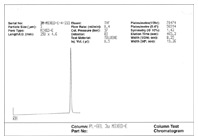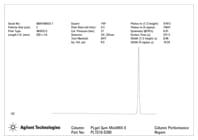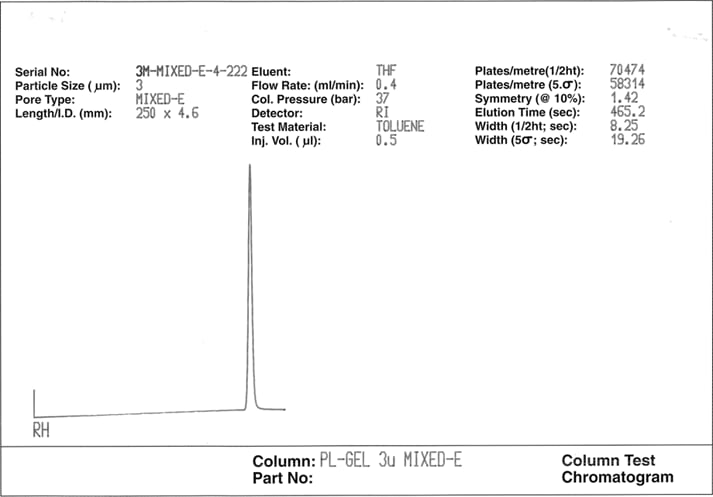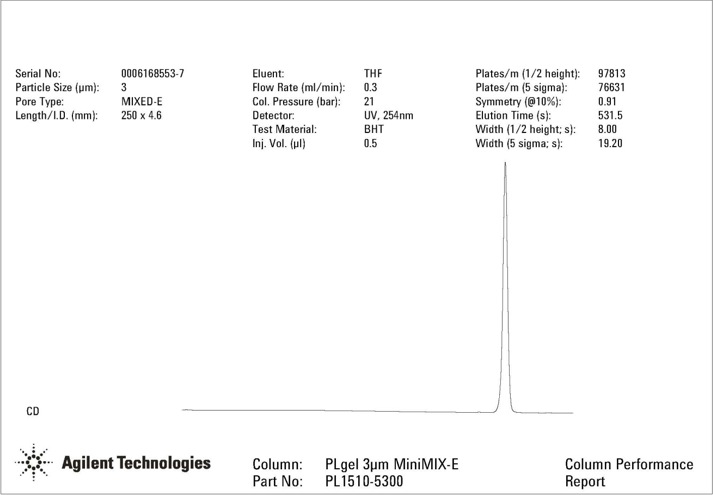Access Agilent eNewsletter, February 2014
>> Update My Profile | Subscribe to Access Agilent | Article Directory

Happy 50th Birthday, GPC!
By Stephen Luke
Agilent GPC Columns Product Manager
2014 marks the 50th year of gel permeation chromatography, or GPC and it is time to celebrate this milestone with Agilent.
The term gel permeation chromatography can be traced back to J. C. Moore, who investigated the technique and published “Gel permeation chromatography. A new method for molecular weight distribution of high polymers” in the Journal of Polymer Science in February 1964.
Moore’s seminal work described GPC as “Polystyrene gels crosslinked in the presence of diluents… made in fine-mesh bead form suitable for packing into chromatographic columns.” The basic technology of GPC remains unchanged to this day, although advances in polymer particle manufacture and quality control have improved data quality and resolution, and greatly increased the range of applications for organic and aqueous polymer analysis.
GPC is a type of liquid chromatography, so it uses solid stationary and liquid mobile phases. However, unlike HPLC, the separation mechanism relies solely on the size and shape of the polymer molecules in solution, rather than any chemical interactions between the particles and the stationary phase.
Gel permeation chromatography employs a stagnant liquid present in the pores of beads as the stationary phase, and a flowing liquid as the mobile phase. This allows the mobile phase to not only flow between the beads, but also in and out of the pores in the beads. The separation mechanism is based on the size of the polymer molecules in solution.
 Enlarge
Enlarge
Figure 1. A 1992 test certificate for an Agilent PLgel MIXED-E, 4.6 x 250 mm, 3 µm gel permeation column.
 Enlarge
Enlarge
Figure 2. A 2013 test certificate for an Agilent PLgel MIXED-E, 4.6 x 250 mm, 3 µm gel permeation column.
Agilent has a long GPC heritage
Agilent has a long history of involvement with GPC. It began back in 1976 when Polymer Laboratories, today a part of Agilent Technologies, first released PLgel columns, along with individual standards and calibration kits for organic GPC. Agilent PLgel MIXED columns, which increased data quality, followed in 1981. PL aquagel-OH columns, which use novel chemistries for the analysis of water-soluble polymers, were introduced to the market in 1990. Further investment led to the 2004 release of Agilent PlusPore columns, high-pore-volume materials for increased resolution, and the EasiVial standard that simplifies calibration procedures. PLgel Olexis columns optimized for polyolefin analysis with the highest resolution and data quality for even ultra-high molecular weight samples were released in 2007.
From the very beginning in 1976 through the present, Agilent’s investment in the quality of its end products has remained the same. Examples of this commitment to quality are shown in Figure 1 and Figure 2. The former shows a column test certificate of a PLgel MIXED-E column dating from 1992, and the latter shows a test certificate for the same type of column, manufactured at the end of 2013.
Discover why we are the polymer analysis people
Agilent’s center of GPC development, manufacture, and distribution is our factory at Church Stretton in the UK. Now you can see for yourself why Agilent says, “We are the polymer analysis people,” by watching a short video that tells the story of our Church Stretton factory – including its 30-year heritage as an innovator in GPC – and how Agilent’s investment in plant, materials and people is building on this legacy. You will see how Agilent’s investment and innovation is providing the complete solution for GPC analysts worldwide.
After you’ve seen the video, explore Agilent’s wealth of useful GPC resources including application compendia, primers, and selection guides. Then select the GPC solutions that you need for your lab. It’s a great way to recognize and celebrate GPC’s 50th birthday!
>> Update My Profile | Subscribe to Access Agilent | Article Directory

